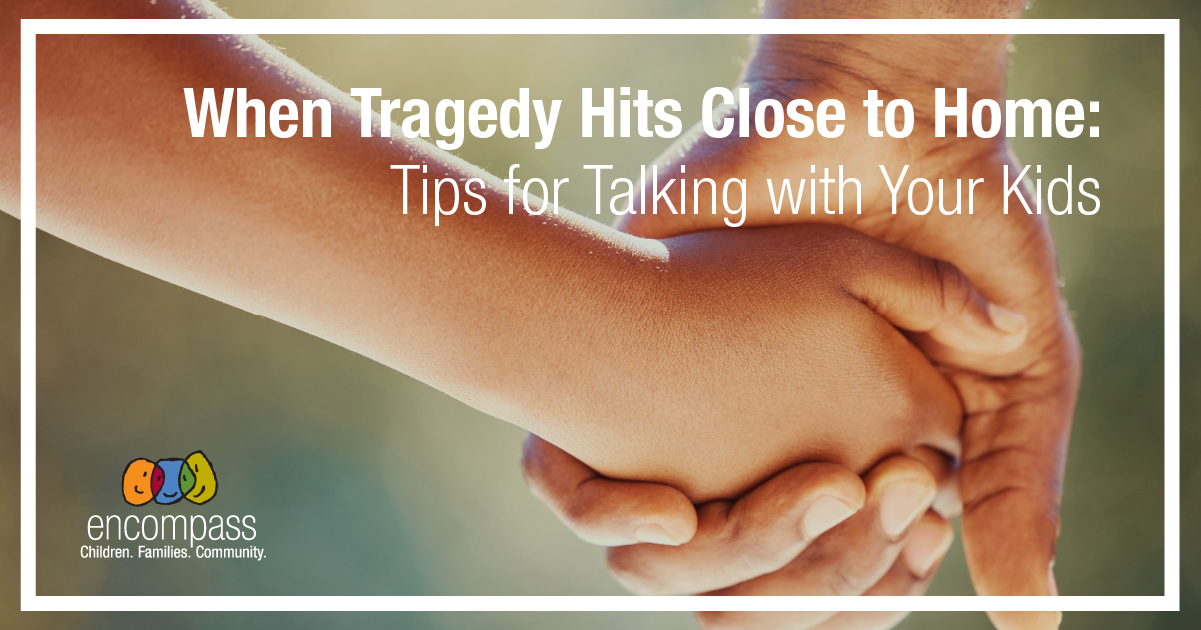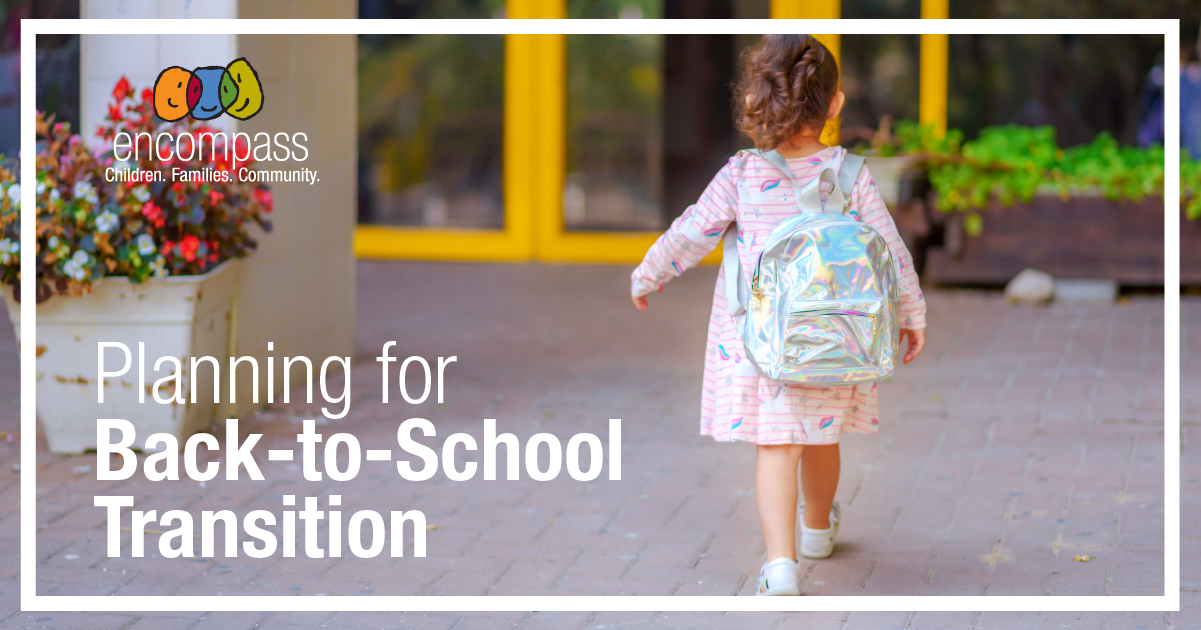Talking to Kids about COVID-19

By Lindsey Cooper, Encompass Clinic Team Supervisor, and Megan Walsh, Encompass Behavioral Health Manager
COVID-19, or coronavirus, has been a whirlwind experience for many of us, especially in the Pacific Northwest. While information from the Centers for Disease Control (CDC) and Public Health assure us that the statistical risks of COVID-19 are minimal for most people, especially children and young adults, this is still an unprecedented experience. The precautions we are taking as a community are a significant change from our typical behavior: working from home, potential (or actual) school closures, and cancellations of events and activities. These changes can feel unsettling and may feel isolating for both kids and parents.
Many adults tend to seek information to increase our sense of calm and control—knowledge is power, right? However, our children often don’t have the same level of access to resources or comprehension of those resources that we do. They aren’t checking the Public Health website or finding reliable, science-based sources for information. The good news is that we can be this source of information for our children and provide that information in developmentally-appropriate ways.
Here are some ideas to consider when discussing this topic with your children.
- First, ask about what they know or have heard about COVID-19. This will be very informative. You might learn that they have a pretty great understanding of this virus, or you might learn that they completely misunderstand it and its implications. You might learn that your child is hearing some scary or unsavory things from peers about the origin of the virus and who can transmit it. Maybe they heard a snippet of a news story or adult conversation and jumped to some conclusions. Whatever you hear when you ask what they know will set the stage for what you address next. If you start to refute their beliefs too quickly, they may shut down and stop telling you what they are thinking, so make sure you hear them out completely. You can respond with simple statements like, “Wow,” or “That’s interesting,” while you are gathering information.
- Normalize their feelings. When your child tells you a belief, ask them how that makes them feel and let them know that you can understand that response and you’ve felt that way before too. Don’t belittle or minimize their feelings even if they don’t make sense to you. You can say things like, “You heard that school might be closed and that makes you feel sad because you won’t get to see your friends. I can understand that your friends are important to you. I was just brainstorming ways to see my friends from work too!”
- Empower them with honest responses and simple steps they can take to protect themselves. Explain that COVID-19 is an illness called a virus that can be spread between people, sort of like catching a cold. Explain that we want to keep everyone safe and healthy, so we are doing special things right now (like washing our hands more, working from home, etc.). Help them move toward being proactive by creating a plan for making hand-washing easier or more effective or creating a strategy for focusing on schoolwork at home.
- Help them feel heard. A powerful technique to help children feel as though you are listening is to repeat back what you just heard them say: “You’re feeling worried because you think you’ll get behind in your schoolwork.” “You’re feeling disappointed because your soccer game was canceled.” An added benefit of this technique is that it is also great to use when you aren’t sure of what to say. Repeating back indicates you are listening and you care about what your child is saying. It also may encourage your child to keep opening up.
- Answer questions. Your child may want to know if they will get sick themselves, or if you will get sick. They may also want to know if someone they love will die from COVID-19. It’s important to calm your child’s fears while staying on message. “It’s normal for people to get sick from time to time, but we don’t expect anyone we know will die. We just want people to stay as healthy as possible right now.” Some kids may benefit from an explanation of the strategy to slow down the virus instead of trying to stop it. Relate it to a situation they’ve probably experienced like: 25 kids needing help from the teacher on an assignment and the teacher is only able to assist a couple people at a time. Instead, if we time it right, and everyone needs help at different times, everyone can get the help they need when they need it.
- Keep checking in. Stay attuned to your child and every so often ask how they feel. In addition to asking about their thoughts and what they’ve heard, ask about how your child is feeling. You can talk about your feelings too. Remember that feelings are okay, so we don’t want to tell our child not to feel a certain way. For example, if your child identifies that they feel scared, instead of saying, “Oh, don’t feel scared,” or “There’s nothing to be afraid of,” maybe ask why they feel scared or what is most scary. Or you can validate your child’s emotions by sharing how you feel and helping them understand that feelings come and go.
- Let your child lead. Just as some adults thrive by watching every newscast and some need to turn off the constant buzz, some kids will need more assurance, information, and support, and others will seem unfazed. It’s important to bring up the topic with children and then be watchful. Watch their behaviors, listen to their words, notice any changes in eating or sleeping patterns, and respond with more nurturing discussions if needed.
- If you see unexpected behaviors, consider they may be coming from a place of fear. When a child does something you don’t want them to be doing, it can be helpful to wonder (both aloud and in your mind) what they hoped would happen when they did whatever it was. Sometimes when we feel stressed and anxious, we can lose access to our usual coping mechanisms and behave in ways we normally wouldn’t. It can help a child open up if we say things like, “Some kids are feeling worried right now, and when I feel worried, it helps me to go for a walk or read a fun book.”
- Catch anxious feelings early. You may notice as you’re watching the news or talking about this issue, you start to feel tightness in your chest or discomfort in your stomach. That is your body’s way of letting you know you are becoming anxious. Being mindful of your own physiologic stress responses can help you choose a calming technique early. Similarly, observe your child for early signs of stress or anxiety. Is your child starting to speak quickly? Become hyperactive? Become extra fussy? These are all signs that your child could use your help with calming down their nervous system. Recognize and name the feeling, and then choose a calming strategy, such as taking deep breaths, lying upside down, drinking water, or physical activity (dance party!). It’s important for your child to watch you handle your big feelings in healthy ways.
- Make a plan for how you will work to experience more calm as a family. Develop a tangible plan for how both you and your child will connect with their social group, either electronically or in small groups (depending on changing recommendations from public health). Talk about your favorite things to do as a family or individuals. Get creative and come up with new ideas, such as going for a hike, preparing for a garden, riding bikes, or walking to the store during times that are unlikely to be busy. Ample research supports the calming benefits of both connecting with nature and physical exercise. The added bonus is the connection to each other and new coping strategies that come with pursuing calm as a family.
We want to make sure that we are absorbing fact-based information, acknowledging the feelings we are experiencing, and prioritizing our own regulation before starting to have these challenging and important conversations with kids. There is a reason why flight attendants tell us to secure our own oxygen masks before attending to others. We need to keep ourselves physically and emotionally strong so that we can ensure the safety of our kids. Practicing the tips listed above will help you connect with your child and build a resilient relationship as we find our way through this challenging time.














